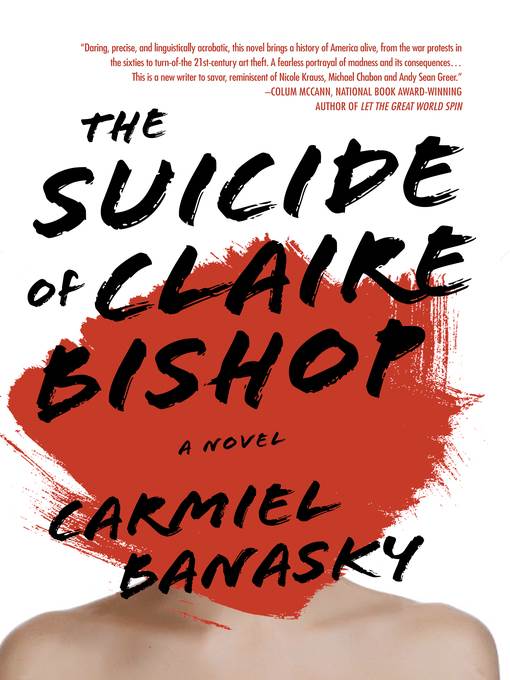
The Suicide of Claire Bishop
A Novel
کتاب های مرتبط
- اطلاعات
- نقد و بررسی
- دیدگاه کاربران
نقد و بررسی

Starred review from July 6, 2015
Banasky’s memorable, intricate, and inventive debut novel uses vulnerable characters to probe themes of time, identity, perception, and love. In 1959 Manhattan, Freddie Bishop commissions an artist known only as Nicolette to paint a portrait of his wife, Claire. Unexpectedly, the finished work depicts fragmentary moments in Claire’s life, ending with a leap off the Brooklyn Bridge. Despite Nicolette’s reassurance that the painting will protect her from the fate it depicts, Claire—fearful of her family’s history of mental instability—attempts unsuccessfully to destroy it. When schizophrenic West Butler sees the painting in a gallery in 2004, he becomes convinced that it is the work of his artist ex-girlfriend, also named Nicolette. Spiraling into a delusion of conspiracy and time travel that explains her disappearance from his life and the contradiction in dates, West concludes that the canvas can change reality as well as help him find Nicolette. In the course of stealing it, he meets a man with knowledge of the painting’s past, setting up an encounter between him and Claire that will have transformative effects on both. With its dancing time frames, recurring motifs, glimpses of history, and shifting realities, all united by striking prose, the novel is both an intellectual tour de force and a moving reflection on the ways we try to save ourselves and others.

July 15, 2015
A complex exploration of tricky memories. Relying on an unreliable narrator is always risky, and Banasky elevates that risk to high art in her audacious but uneven debut. First we meet Claire, a gloomy 1950s housewife sitting for a portrait. The painter, Nicolette, attracts and disquiets her-then renders an oil-and-canvas vision of Claire's suicide that haunts everyone who sees it, including the subject. Fast-forward to 2004, the era of West, whose compulsions propel much of the story. West has schizophrenia, and as he tries to track down a former lover (also a painter named Nicolette) whose work obsesses him, he yanks us deeper into the unsolvable labyrinth of his mind. Each section tackles a different point in the years between the painting's creation and West's attempt to recapture it, and though it frequently gets lost or stolen or damaged, Claire's portrait is the only focal point in a craggy landscape. This can feel either exhilarating or exhausting, depending on the strength of your stomach. It bears mentioning that Banasky writes beautifully and with great empathy: in one quiet sequence, Claire cares for her estranged mother as the older woman succumbs to Alzheimer's; in another, West pays his parents a surprise visit so he can try to connect with Nicolette via a portal in his childhood bedroom. Come to think of it, all the broken souls here do share one thing besides a sinister painting-a dicey relationship with the past. So if you're comfortable with uncertainty, you'll feel right at home in Banasky's imagination. Come for the author's gift with language, but don't expect it to offer you peace of mind.
COPYRIGHT(2015) Kirkus Reviews, ALL RIGHTS RESERVED.

Starred review from November 1, 2015
In 1959 New York, Claire Bishop, young and pretty but a willful, heavy-drinking fabulator who married Freddie to escape what felt like a doomed life, is sitting for a portrait he has commissioned for her birthday. She's drawn out by the artist, Nicolette, who then paints a shocking portrait of Claire's broken-bodied suicide. In 2004, the earnest, schizophrenic West sees the portrait of a woman's suicide that he's convinced has been painted by a woman named Nicolette with whom he's been trying to connect. But given the time difference, how can that be? Debut novelist Banasky offers a brilliantly, sleekly told puzzle piece that snares readers to the end. VERDICT Highly recommended.
Copyright 2015 Library Journal, LLC Used with permission.

September 1, 2015
After sitting for a portrait, Claire Bishop finds that the artist's finished painting depicts her making a suicidal jump from a bridge. Banasky uses this painting in her first novel to link unhappy housewife Claire's life to schizophrenic West Butler, an art thief and unlikely player in her future. Through simultaneously precise, beautiful, and frightening descriptions of West's warped perceptions, the reader experiences his thin grasp of reality while also feeling his desire for clarity ( I am a detective in search of myself ). Banasky also expertly portrays Claire's fear of madness and search for meaning. Although the novel's structure suggests a chronological approach, its nonlinear sections make story elements more challenging to follow. But a careful reader is rewarded by Banasky's skillful character development, innovative points-of-view technique, and fresh language. The book is full of quotable sentences, including one descriptive of the book itself, Here's the truth: we're all connected, but not in a straight line. More like constellations, or islands. (Reprinted with permission of Booklist, copyright 2015, American Library Association.)

























دیدگاه کاربران